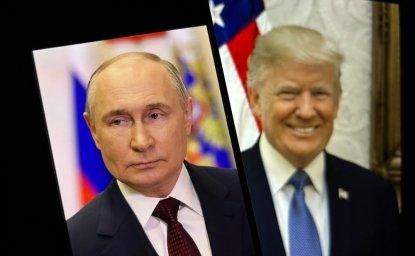Culture/Kultura: Russian Influences on American Performing Arts: Theater

"The Russian actors and teachers of the late 19th and early 20th century had an immense effect on the acting traditions of the United States," stated Leslie Jacobson, Professor and Chair, Department of Theater at the George Washington University at a Kennan Institute seminar on 10 October 2003. Jacobson, joined by Andrei Malaev-Babel, Producing Artistic Director, Stanislavsky Theater Studio and Sarah Kane, Artistic Associate, Stanislavsky Theater Studio, recounted how the teachings of Konstantin Stanislavky and Michael Chekhov influenced generations of American stage and film actors.
Starting in the late 19th century, the style of playwriting began to change, according to Jacobson. In plays by Shakespeare and other classical playwrights, she noted, "you did not have to wonder what a character was thinking or feeling—all you had to do was hear the dialogue." Playwrights such as Henrik Ibsen, Anton Chekhov, and others influenced by them began to write plays with both text and subtext, where things that were not said were often just as important as the actor's lines. "A new kind of actor and acting style needed to develop to serve these plays," said Jacobson.
During this era, according to Maleev-Babel, Stanislavsky began developing a different kind of theater in rebellion against the "clichéd acting" of the 19th century, where every emotion had certain gestures and expressions associated with it, and staging was generic and interchangeable between productions. The acting style he developed emphasized the psychological internal life of the character, and forced the actor to "truly create a role."
Maleev-Babel noted that Stanislavsky evolved over time, and the evolution of his teachings outside Russia was driven by when and which of his books were translated, by the acting coaches who studied under him and emigrated to the United States, and by what elements of his work were "marketable" and suitable for a teaching system that students could buy. Stanislavsky's tremendous influence in the United States also stemmed from contacts with the Federal Theater Project set up under the WPA, and with the Group Theater Company based in New York, founded by Cheryl Crawford, Harold Clurman, and Lee Strasberg. Strasberg and other prominent American artists traveled to Moscow to see Stanislavky's work in the Moscow Art Theater firsthand and to speak with him.
The generation of actors, directors, and producers who gained prominence in the 1940s, 50s, and 60s came out of programs like the Group Theater Company, stated Jacobson. Lee Strasberg went on to break from the Group Theater Company to form his own school, which placed greater emphasis on personal experience and improvisation. What they were all teaching was the "Stanislavsky System," which was also known as "method acting." Initially developed for the stage, the system would prove to be especially effective in films, where non-textual communication was even more important.
Sarah Kane spoke about the importance of Michael Chekhov, nephew of the writer Anton Chekhov and a famous Russian actor who went on to influence many actors in America. A student and colleague of Stanislavsky for thirty years, Michael Chekhov was forced to emigrate from Soviet Russia in 1928 when his productions became politically unacceptable. After performing and teaching for ten years in Europe, Chekhov relocated to the United States at the outbreak of WWII. He worked with actors in Connecticut and Hollywood, among them Yul Brynner (who was also born in Russia), Gregory Peck, Jack Palance, Marilyn Monroe, Anthony Quinn, Clint Eastwood, and Gary Cooper.
Kane related an anecdote about Gary Cooper working on a movie set early in his career. He was struggling with a particular scene—requiring take after take—when the director called for a break. Cooper worked on a Michael Chekhov acting exercise for five minutes, then returned to nail the scene in the next take. According to Kane, Cooper went on to win the lead in High Noon based on his performance in that early movie. In addition to teaching, Chekhov also appeared in a number of American films. He received an Academy Award nomination for his role in Alfred Hitchcock's Spellbound in 1954.
During the seminar, the panelists showed three scenes to showcase American actors using the Stanislavsky method: Karl Malden in A Streetcar Named Desire, Montgomery Clift in A Place in the Sun, and James Dean in Rebel Without a Cause. The Stanislavsky method remains in use by actors today, such as Jack Nicholson and Al Pacino. "A lot of the teachings of great Russians early in the 20th century helped make that style of acting possible here in America in the later 20th century and even into the 21st century," concluded Jacobson.
After the presentations, Steve Wilhite, an actor from the Stanislavsky Theater Studio, performed "The Grand Inquisitor" scene from the Stanislavsky Theater Studio production of The Brothers Karamazov.
Author


Kennan Institute
After more than 50 years as a vital part of the Wilson Center legacy, the Kennan Institute has become an independent think tank. You can find the current website for the Kennan Institute at kennaninstitute.org. Please look for future announcements about partnership activities between the Wilson Center and the Kennan Institute at Wilson Center Press Room. The Kennan Institute is the premier US center for advanced research on Eurasia and the oldest and largest regional program at the Woodrow Wilson International Center for Scholars. The Kennan Institute is committed to improving American understanding of Russia, Ukraine, Central Asia, the South Caucasus, and the surrounding region through research and exchange. Read more

Explore More
Browse Insights & Analysis
The OSCE is a Good Value for America

Infographic | Russia's Illegal Annexation of Crimea

Russia’s Indigenous Communities and the War in Ukraine
